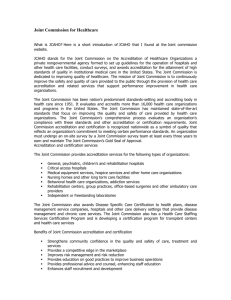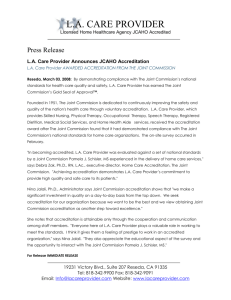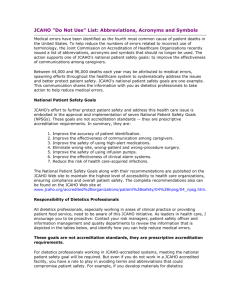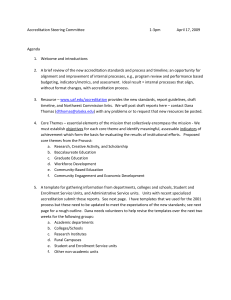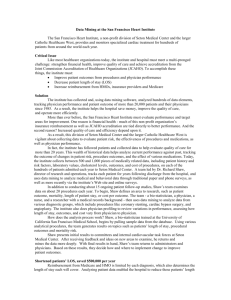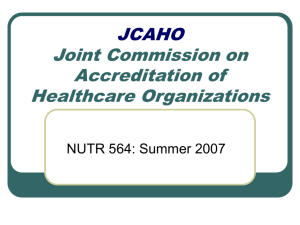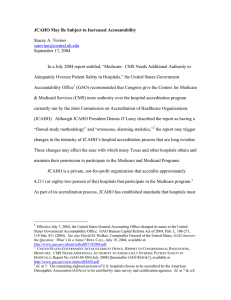Joint Commission on the Accreditation of Healthcare Organizations
advertisement
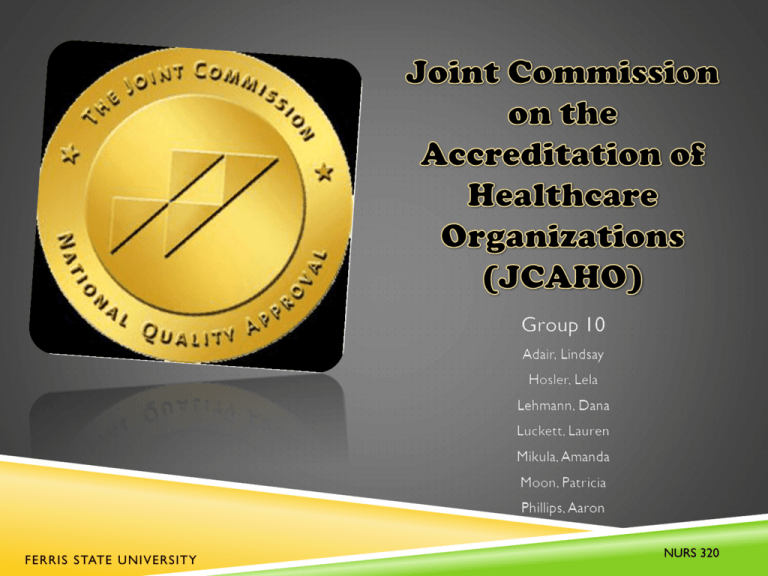
FERRIS STATE UNIVERSITY NURS 320 Joint Commission on the Accreditation of Healthcare Organizations is a private, nonprofit organization whose mission is to continuously improve the safety and quality of care provided to the public; it does this through the provision of health accreditation and related services that support performance improvement in health care organizations. To continuously improve health care for the public, in collaboration with other stakeholders, by evaluating health care organizations and inspiring them to excel in providing safe and effective care of the highest quality and value. All people always experience the safest, highest quality, bestvalue health care across all settings. (SAUNDERS, 2003) (TJI,2012) (JCI, n.d.) 1910 Ernest Codman, M.D., developed the “end result system of hospital standardization.” This system allowed hospitals to track patient outcomes and allowed hospitals to correct ineffective outcomes to allow similar cases to be treated successfully in the future. 1951 The Joint Commission on Accreditation of Hospitals (JCAH), a not- for-profit organization is formed in Chicago, Illinois. 1987 JCAH changes its name to the Joint Commission on Accreditation of Healthcare Organizations (JCAHO). 1998 The Sentinel Event Policy is revised, effective April 1, to promote self- reporting of medical errors and encourage health care providers to more closely examine the root causes of these events. (TJC , 2012) “The Joint Commission evaluates and accredits more than 19,000 health care organizations and programs in the United States”. “The Joint Commission is the nation's oldest and largest standards-setting and accrediting body in health care”. (TJC , 2012) Many medical facilities rely on JCAHO accreditation procedures to indicate to the public that their particular institution meets quality standards. JCAHO standards are not mandated, however it is recommended that these guidelines should be considered when designing or improving processes. Practitioners are expected to consider the recommendations found in knowledge-based sources, such as professional medical societies and physician organizations, nursing and allied healthcare associations. (SPATH, 2002) Implement evidence-based practices to prevent indwelling catheter- associated urinary tract infections (CAUTI). Insert indwelling urinary catheters according to established evidence-based guidelines that address the following: Manage indwelling urinary catheters according to established evidence-based guidelines that address the following: Securing catheters for unobstructed urine flow and drainage Maintaining the sterility of the urine collection system Replacing the urine collection system when required Collecting urine samples TJC , 2012) Measure and monitor catheter-associated urinary tract infection prevention processes and outcomes in high-volume areas by doing the following: Selecting measures using evidence-based guidelines or best practices Monitoring compliance with evidence-based guidelines or best practices Evaluating the effectiveness of prevention efforts TJC , 2012) What Is Accreditation? “a process in which an entity, separate and distinct from the health care organization, usually nongovernmental, assesses the health care organization (in this instance, the laboratory) to determine if it meets a set of requirements designed to improve quality of care.” Who Can Gain Accreditation? Hospitals Doctor’s Offices Nursing Homes Office-based Surgery Centers Health Treatment Facilities Providers of Home Care Services Aids in improving patient safety Strengthens the communities confidence in the services and treatments they are receiving Provides a competitive edge in the marketplace Improves risk management and risk reduction Attempts to decrease liability insurances Educates businesses to improve operations Provides professional advice and education to staff Enhances staff recruitment and development Gives authority for Medicare certification. Generally recognized by insurers and other third parties Helps develop a framework for organizational structure and management Helps fulfill regulatory requirements in select states Gives tools to accredited organizations Depends on the facility seeking accreditation. Depends on eligibility requirements Accreditation is voluntary. JCAHO surveyors come to the facilities where accreditation is sought for an intense on-site review. Then facilities receives a report identifying its strengths and outlining what it could improve. “At the conclusion of a survey, the Joint Commission issues a report listing Requirements for Improvement (RFIs), areas where an organization must respond with corrective action plans. There are two different kinds of RFIs”. “Direct impact RFIs: Direct RFIs are areas of sufficient concern that the Joint Commission believes noncompliance could pose an immediate risk to patient safety or quality of care. To avoid review of accreditation status by the Joint Commission’s central office, a hospital of our type must receive fewer than 13 RFIs on the hospital survey and fewer than 5 RFIs on the laboratory survey. Additionally, a hospital must submit a corrective action plan addressing each direct impact RFI within 45 days”. “Indirect impact RFIs: Indirect impact RFIs are considered to pose a less immediate risk to patient safety and quality of care. These RFIs do not have a bearing on an accreditation decision, but are still relevant and important to providing high-quality, safe patient care. A hospital must respond to these findings with a corrective action plan within 60 days”. (MGH, 2012) “The definition of “corrective action” is a structured effort to improve suboptimal performance identified through the performance improvement monitoring process. Corrective actions are not the end of the problem or loop closure. Actions are to create a forward momentum for an outcome change. Actions should be viewed as positive and multifaceted within a variety of categories. Action plans can generally be categorized into three areas: patient-specific, provider-specific or system-specific”. “Action plans should be dynamic, flexible and meaningful. Action plans should emphasize positive change; include components of issue identification, data analysis, model for implementation and evaluation and re-evaluation for loop closure. This would be defined in a performance improvement plan”. ( SOCIALTEXT, 2012) Certain deficiencies found during a survey require audits to be completed over a four month period of time. When these audits are started a goal of 90-100% should be set. These audits should show proof that the deficiencies were fixed. If the facility’s goal was not met it could require more audits and or adjustments to be made to meet goal. This process is called Measures of Success. When completed, if goals are maintained or exceeded, the facility maintains accreditation. If the plan falls short of its goal, more may be required of the facility. If the survey reveals multiple unsafe practice standards, it could result in a follow up survey. During the follow up survey ,JCAHO can look at everything, not just the deficiencies that were found the first time. This can result in more follow up surveys including one from CMS. HOSLER, L. (INTERVIEWER) & CODMAN, J. (INTERVIEWEE). (11 -29-2012) They focus on problems in health care safety and how to solve them. The goals are specific for each area of patient care. Identify patients correctly Identify patient safety risks Double identifiers Patients at risk for suicide Improve staff communication Report test results Use medicines safely Prevent mistakes in surgery () Blood thinners, labeling, record home medications Prevent infection Hand washing, surgical, urinary catheters, central lines JACHO, 2012 Correct site / site marking, universal protocol Prevent residents from falling High risk/ long term care) Prevent bed sores High risk/ long term care) Instituted in 2001. These reflect focus areas in which data is collected to help improve delivery of health care. For each core measure there is corresponding accountability criteria and outcome measures. Until recently, there has been four core measure sets for accredited general medical/surgical hospitals: acute myocardial infarction (AMI), heart failure, pneumonia, and Surgical Care Improvement Project (SCIP). Two additional core measure sets will soon be implemented that relate to perinatal care and a set from the approved complement of core measure sets. (ZHANI, 2012) Surgical Care Improvement Project (SCIP) (i.e.: initial antibiotic timing) Acute myocardial infarction (i.e.: administration of fibinolytic therapy within 30 minutes) Substance use Heart failure Tobacco treatment Hospital – based inpatient Venous thromboembolism psychiatric services Pneumonia measures Perinatal care Immunization Stroke Children’s asthma care Hospital Outpatient (JACHO, 2012) department I currently work on a medical/surgical unit at West Shore Medical Center (WSMC) in Manistee. JCAHO influences my nursing practice by providing the most up-to-date evidence based practices. WSMC is monitored by the Internal Organization for Standardization (ISO). Although my facility is not JCAHO, many of JCAHO standards are expected to be taken into consideration for policies/procedures for the safest and most sufficient patient care. My facility adheres very strictly to infection control standards and we follow a “Wash in, Wash out” policy. We sanitize our hands when we enter a patient room and sanitize them again on our way out of the room. This is done every time for every patient. I use sterile precautions when starting IVs. If a medication is to be administered via the IV route, the access site is sterilized. It guides my practice by setting standards of care by enforcing guides such as acceptable abbreviation list, learning/educational material, evidence based practice information, and patient safety guides. Particularly in home hospice care: JCAHO guides our practice by providing guidelines on things such as: Education based on evidence based practices to prevent patient falls in the home Create and educate patients on their medications Identify and educate on in home patient safety As a nurse it guides our collaboration of care and supervision of an interdisciplinary team . In my current position as a supervisor at a Long Term Acute Care Hospital JCAHO guides my practice by setting standards that are evidence based. Part of my responsibility includes monitoring the staff to make sure that he/she is following current safe practice standards. JCAHO is able to visit a facility unannounced at any time so every member of my team needs to work in a constant state of readiness for a survey. It is my responsibility to provide in the moment teaching for staff members that may be practicing outside of those standards. Some of those standards we are working on at this time include infection control, central line associated blood infections, and catheter associated urinary tract infections. I work at the Grand Traverse Pavilions in Traverse City Michigan. This is a long term care facility. We are not a JCAHO accredited facility. The practice standards of the Joint Commission influence my nursing practice in a nursing home by: Bed requirements- this defines the occupancy allotment of the facility We have specific isolation rules for residents in isolation. This differs than the hospitals. National Patient Safety Goals pertinent to the perioperative area including hand washing, patient identification and medication labeling Development of the Universal Protocol to ensure the correct procedure is being done on the correct patient Sentinel Event review to process errors and omissions to prevent reoccurrence Surgical Site Infection (SSI) prevention guidelines to ensure proper antibiotic prophylaxis Accreditation Requirements that are recognized and promoted by AORN JCAHO is not affiliated with the MDOC MDOC utilizes standards of care from the National Commission on Correctional Health Care (NCCHC) and the National Council on Quality Assurance (NCQA) Although MDOC in not JCAHO accredited, It is important for correctional nurses to understand these standards to ensure a consistent nursing practice. JCAHO helps correctional nurses deliver safe quality health care to inmates. (MICHIGAN, 2012) (NCCHC , 2012) Saunders (2003). Miller-Keane Encyclopedia and Dictionary of Medicine, Nursing, and Allied Health. Retrieved from, http://medicaldictionary.thefreedictionary.com/JCAHO Joint Commission International (JCI) (n.d.) The Joint Commission Organization. Retrieved from, http://www.jointcommissioninternational.org/The-JointCommission-Organization/ The Joint Commission (TJC) (2012). History of the joint commission. Retrieved from, http://www.jointcommission.org/about_us/history.aspx Michigan.gov (2012). Department of corrections: health care. Retrieved from: http://www.michigan.gov/corrections/0,4551,7-119-9741_11776---,00.html National Commission on Correctional Health Care (NCCHC) (2012). Regulations, Standards and Policies. Retrieved from: http://www.ncchc.org/pubs/CC/CNP/8_regulations.html Kusler-Jensen, J.(2009 September). Perioperative Implications of the Joint Commission’s 2009 Accreditation Requirements. AORN Journal (90) 3 JCAHO. (2012). Core Measures. Retrieved from http://www.jointcommission.org JCAHO, (2012). Universal Protocol. Retrieved from http://www.jointcommission.org/standardsinformation/up.aspx JCAHO, (2012). Sentinel Event Policy and Procedures. Retrieved from http://www.jointcommission.org/SentinelEventPolicyandProcedures/ JCAHO, (2012). Hospital National Patient Safety Goals. Retrieved from www.jointcommission.org Community Health Centers, Inc. (n.d.) Joint commission on accreditation of healthcare organizations. Retrieved from http://www.chc-ut.org/Web%20Pages/jcaho.htm Joint Commission International (JCI) (n.d.) Common questions and answers regarding JCI accreditation, clinical laboratories, and these standards. Retrieved from www.jointcommissioninternational.org Slavin, P. L. (2009) Joint commission survey results. Retrieved from http://qualityandsafety.massgeneral.org/jcaho/summary_0909.aspx Tinkoff, G. (2007) Corrective action plans. Retrieved from https://www.socialtext.net/acsdemo-wiki/corrective_action_plans
